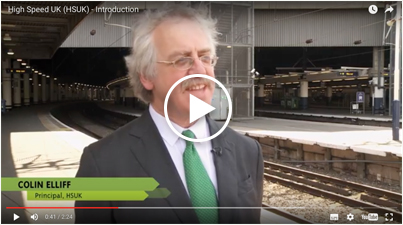CHEAPER
£20bn less than existing plans for HS2 & HS3.
BETTER CONNECTED
Improves 94% of journeys and reduces journey time by an average of 40%.
CLEANER
Saves 600 million tonnes of CO2 and avoids the Chilterns AONB.
SMARTER
Improves regional rail across the UK and integrates with the existing rail infrastructure.
















The work of High Speed UK is guided by some of the great thinkers of modern times:
1. “We choose to go to the moon… not because it is easy, but because it is hard.”
John Fitzgerald Kennedy, 35th US President, in speech at Rice Stadium, Houston, 1962
Anybody with a straight edge and a complete disregard for the UK’s natural environment and landscape can do the easy thing, and design the super-
2. “Less is more.”
Ludwig Mies van der Rohe, architect, 1886-
We couldn’t have put it better ourselves.
3. “We’ve got to do something… this is something… let’s do it!!”
The Politician’s Syllogism, explained in Yes Prime Minister, 1988 (S2, Ep5)
Without the competence to design a national railway network, or even the understanding of the importance of network, the progenitors of HS2 hardly knew which way to turn when former Transport Secretary Andrew Adonis suggested that the time had come to build new railways. If we’d written our paper Understanding UK Intercity Connectivity 10 years ago, it might have proved useful.
4. “Those who do not understand history are doomed to repeat it.”
Edmund Burke, Irish statesman and philosopher, 1730-
This is another self-
During the 17 years that Curzon Street Mk1 lasted the London & North-
Exactly the same logic is likely to apply in the 21st Century. HS2 Ltd’s Curzon Street proposals are equally doomed to failure, and they will leave the UK with a permanently fragmented national network.
5. “Some men see things as they are, and ask ‘why?’… I dream of things that never were, and ask ‘why not?’.”
John Fitzgerald Kennedy, 35th US President, quoting George Bernard Shaw, in speech to Irish Parliament, 1963
It’s necessary to think outside the box. No-
6. “The methods of the great pioneers have often puzzled conventional minds.”
Ernst Stavro Blofeld, voiced by Telly Savalas, On Her Majesty’s Secret Service, 1969
We certainly wouldn’t advocate launching an ‘Omega Virus’ upon humanity, as Blofeld intended. But we sometimes feel his pain, when fellow railway professionals seem unable to comprehend the self-
7. “It is difficult to get a man to understand something, when his salary depends upon his not understanding it.”
Upton Sinclair, American writer and philosopher, 1878-
Upton Sinclair’s words crystallise perhaps the greatest malaise of modern civilised society. All too often, old-
8. “We will fight them in the beechwoods…”
Winston Churchill, UK Prime Minister, in speech to Parliament, 1940.
OK, this isn’t exactly what Winston said. But we have little doubt that the great man would have used very similar words, had he been confronted with proposals as daft as the proposed HS2 route through the Chilterns – devastating an Area of Outstanding Natural Beauty, and requiring 50km of tunnel to get to Birmingham, when HSUK’s alternative M1 route requires just 12km and completely avoids the Chilterns. As Winston did say: “This is nonsense up with which I will not put.”
9. “The aim of the HS2 project is to deliver hugely enhanced capacity and connectivity between our major conurbations.”
Evidence statement given by Andrew McNaughton, HS2 Ltd Technical Director, to House of Commons HS2 Select Committee, 30th November 2015.
Andrew McNaughton’s words are the perfect encapsulation of the objectives of a well-
However, Andrew’s aspiration for “hugely enhanced capacity and connectivity” conceals a highly inconvenient truth; when considered across the scope of the UK’s national network, HS2’s capacity and connectivity gains are pitifully small, and are dwarfed by the vastly superior performance of the High Speed UK alternative. For more information, please consult: HS2 – High speed to Failure.
OUR PHILOSOPHY




“HS2 modelling is shocking, biased and bonkers.”
Margaret Hodge, Chair, Public Accounts Committee

“No economic case for HS2... it will destroy jobs and force businesses to close.”
Institute of Economic Affairs


WATCH OUR VIDEO

